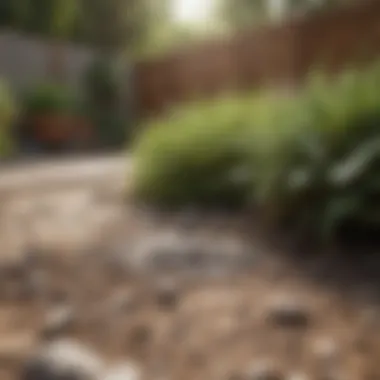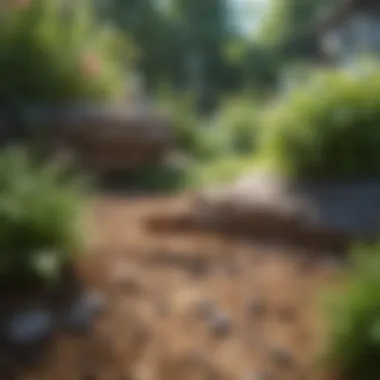Natural Ant Control: Effective Home Remedies for Your Yard


Intro
Ants are often a nuisance in gardens, backyards, and outdoor spaces. Their ability to form colonies and reproduce quickly makes them challenging to control. Understanding the type of ants invading your space is essential. Knowing their behaviors and food preferences can lead to more effective home remedies.
This article will explore various methods of ant control that utilize common household items. Using these remedies not only minimizes the use of chemicals but also promotes safety for pets and children. Moreover, adopting sustainable practices ensures an eco-friendlier approach in managing these pests.
Many homeowners seek natural solutions because traditional pesticides can harm beneficial insects and the wider ecosystem. In this guide, we will cover several effective home remedies, application techniques, and preventive measures you can take to maintain an ant-free yard.
By incorporating these strategies, readers can manage their ant problems while keeping their environment safe and healthy.
Key Insights and Trends
Understanding current trends in pest control reveals a shift towards more natural solutions. Homeowners prefer remedies that are effective yet gentle on the earth. This movement encourages practices that reduce our reliance on synthetic chemicals. The increased awareness of environmental issues has led to the popularity of natural ant control methods.
Popular Gardening Techniques of the Season
As gardens flourish in the warmer months, maintaining a balance between aesthetics and pest control is crucial. Some of the techniques homeowners are currently utilizing include:
- Companion planting to deter ants naturally. Plants like mint, rosemary, or marigolds can repel ants and other pests.
- Using barriers made from natural substances such as diatomaceous earth, which is harmless to plants but effective against ants.
- Regularly maintaining clean outdoor spaces by removing organic debris and food particles that attract ants.
These gardening techniques align with those looking for sustainability in their gardening practices.
Practical Tips and How-To Guides
Homeowners should consider the specifics of their situation before applying ant control solutions. Here are some essential steps:
- Identify the Ant Species: Knowing if the ants are carpenter ants, fire ants, or sugar ants can determine the right approach.
- Set Up Bait Stations: Use natural bait like sugar water mixed with borax. Place it near ant trails, allowing ants to carry it back to their colonies.
- Create Deterrents: Mixtures like a water solution with vinegar or lemon juice can deter ants; spray this solution around entry points.
- Practice Regular Maintenance: Ensure to trim vegetation and remove debris to reduce potential nesting sites.
- Monitor Effectiveness: Keep track of ant activity. Adjust methods if the ants return.
"Sustainable solutions not only target current pests but also help in preventing future infestations."
By integrating these practical tips into your routine, you can take charge of the pest-neutralizing process in your outdoor spaces, creating a more enjoyable environment.
Understanding Ant Behavior
Understanding ant behavior is critical when implementing ant control strategies in your yard. By recognizing the biology and social structure of ants, homeowners can tailor their remedies effectively. This knowledge helps in identifying ant species present in your garden, allowing for targeted actions that minimize both environmental impact and human effort.
Biology and Social Structure of Ants
Ants belong to the family Formicidae and are known for their complex social structures. They live in colonies that can number from a few dozen to millions of individuals. Each ant plays a specific role—workers, soldiers, and queens. Workers gather food, maintain the nest, and care for the young, while soldiers defend the colony. Understanding these roles can aid in choosing the appropriate control methods.
Ants communicate through pheromones, which are chemicals that convey information about food sources or danger. This communication is essential for survival and helps the colony function cohesively. Disrupting these trails using natural remedies can be an effective way to control their movements in your yard.
Common Ant Species in Gardens
Various ant species could invade garden spaces, each with unique behaviors and characteristics. Recognizing these species enables effective and targeted treatment strategies.
Sugar Ants
Sugar ants are known for their attraction to sweet substances. These ants play a vital role in pollination and seed dispersal, aiding in the health of your garden. One key characteristic is their ability to form large foraging parties, which makes them a common sight. For homeowners, they could either be a beneficial presence or an annoying nuisance, especially when they invade kitchens or dining areas.
Their unique feature is their diet, which primarily consists of sugary substances. This presents an advantage when using natural remedies like sugar-water traps, which lure them away from gardens. However, their presence may signal overripe fruits or spills that require attention.
Carpenter Ants


Carpenter ants are significant because they excavate wood to create their nests, often causing structural damage to homes and outdoor structures. They are among the larger ant species, making them easily identifiable. These ants are a concern in the garden as they can weaken wood-based structures, leading to higher repair costs for homeowners.
Their unique behavior of nesting in damp wood can be utilized in control strategies. For example, eliminating moist wood and sealing potential entry points can deter them. However, their removal often requires more than natural remedies, especially when infestations are severe.
Fire Ants
Fire ants are known for their painful stings and aggressive nature. They are particularly notorious for forming mounds in yards. Their key characteristic is the seasonal swarming behavior, which can lead to rapid population increases. They are especially common in warmer climates and can pose a risk to children and pets.
The unique feature of fire ants is their ability to work collectively, leading to aggressive defense of their nests. Natural remedies such as boiling water may help, but caution is essential to prevent stings. Their presence highlights a need for regular maintenance and monitoring to prevent larger invasions.
Reasons for Ant Invasions
Ant invasions typically occur due to several factors, including availability of food sources, nesting sites, and environmental conditions. Gardens that offer abundant food sources, such as fallen fruit or exposed sugary items, naturally attract ants. Additionally, areas with moisture can serve as ideal nesting spots, allowing colonies to thrive.
When addressing ant problems, it is essential to understand the reasons behind their invasions. Homeowners can reduce their appeal by maintaining clean outdoor spaces, clearing debris, and ensuring proper waste disposal. Through awareness and proactive measures, managing ant populations in the yard becomes a more manageable task.
Natural Remedies for Ant Control
Natural remedies for ant control are valuable for those seeking a safe and effective way to manage ant populations. These remedies often consist of ingredients that are readily available, cost-effective, and environmentally friendly. They tend to cause minimal harm to beneficial insects and the surrounding ecosystem. In contrast to chemical pesticides, which may pose health risks to humans and pets, natural solutions emphasize practicality while being mindful of sustainability. Homeowners can implement various methods to keep their yards ant-free without resorting to harsh chemicals.
One must also consider factors like the specific type of ants involved and the extent of the infestation when selecting a remedy. Traditional approaches may not suit every situation, so experimentation and observation can lead to successful ant control. This proactive approach allows homeowners to maintain a balance in their outdoor environment while keeping ants at bay.
Vinegar Solutions
Vinegar stands out as a simple yet effective natural remedy for ant control. Its strong scent is unappealing to ants, disrupting their pheromone trails and preventing them from finding food sources. To utilize this solution, mixing equal parts of water and white vinegar in a spray bottle is sufficient. Spraying landscapes, entry points, and visible ant trails can lead to noticeable results. This approach not only repels ants but also cleans surfaces, further enhancing its utility in household cleaning. Its non-toxic nature makes it an excellent choice for families with children or pets.
Essential Oils
Essential oils have gained recognition for their effectiveness in repelling ants, mainly due to their potent scents. Different oils offer various advantages in this regard.
Peppermint Oil
Peppermint oil is particularly renowned for its insect-repelling properties. Its strong aroma works as a deterrent for many pests, including ants. As a beneficial choice for natural ant control, its active compounds create an environment that ants find unpleasant. One of its unique features is its versatility; it can be used not only in gardens but also in indoor spaces. However, care should be taken when applying it, as excessive use might irritate skin or reactions in sensitive individuals would be possible.
Lemon Oil
Lemon oil is another effective option, offering a fresh scent that humans find pleasant but pests do not. It acts as a natural cleaner and disinfectant as well, making it a dual-purpose remedy. When ants come into contact with lemon oil, they often retreat. Its key characteristic is its ability to mask the pheromone trails, which prevents ants from communicating effectively. However, users should be cautious with the concentration, as high levels can be overpowering.
Tea Tree Oil
Tea tree oil is recognized for its medicinal properties, but it also serves as an effective ant repellent. The oil's strong scent disrupts the communication pathways of ants. Forwarding its benefits, tea tree oil can inhibit the establishment of colonies. Its advantage lies in its antibacterial and antifungal properties, making it suitable for broader pest control scenarios. Nonetheless, it is crucial to dilute it properly, as undiluted tea tree oil can be harmful to humans and pets.
Diatomaceous Earth
Diatomaceous earth is a powdery substance that consists of fossilized algae. This unique product works by physically damaging the exoskeletons of ants, causing dehydration. Sprinkling diatomaceous earth in areas of ant activity can significantly reduce their population over time. It is non-toxic to humans and pets, which adds to its appeal. However, while effective, it may require reapplication after rain or watering.
Boric Acid Baits
Boric acid is another highly effective remedy when used in baits. Mixing it with sugar or other attractants can lure ants to the bait, where they ingest the boric acid while taking food back to their colonies. The effectiveness of this method lies in its ability to impact not just individual ants but entire colonies. Care must be taken during application, as boric acid can be hazardous to pets and children if ingested in significant amounts.
Soapy Water Mixtures
A simple solution combining soap and water can effectively kill ants on contact. Soap disrupts the ants' ability to breathe, leading to their demise. This method is straightforward: mix water with a few tablespoons of dish soap in a spray bottle and apply it directly to the ants. This remedy is not only easy to prepare but also utilizes common household materials. However, its impact is temporary and may require multiple applications.
By understanding and utilizing these natural remedies, homeowners can create a safe and effective strategy for managing ants in their yards.


Application Techniques
Effective application techniques play a crucial role in ant control, as they determine how well various home remedies work in deterring and eliminating ant populations. Proper application ensures that the chemicals or natural remedies reach the ants and their nests while minimizing potential harm to surrounding plants, pets, and the environment. Understanding how to identify ant trails and employing diverse methods of application can enhance the effectiveness of these remedies. Homeowners can benefit from learning about specific techniques that are simple to implement yet powerful against ant invasions.
Identifying Ant Trails
Before applying any remedy, it is vital to locate the paths ants use for their daily activities. Ant trails often appear as thin, winding lines on the ground. Common signs include the presence of dozens of ants moving in a straight line, which indicates a strong foraging or nesting pathway. By tracking these trails, homeowners can accurately target the areas where application will have the greatest impact. Key locations include:
- Near entry points like doors and windows.
- Around the perimeter of the house.
- Close to food sources or garbage bins.
Identifying these trails not only maximizes the potential success of treatments but also helps in understanding the nesting sites, allowing for more effective remedies.
Method of Application
Direct Application
Direct application involves applying a remedy straight onto the ant trails or in areas where ants are spotted. This method is particularly effective because it targets the ants immediately. The key characteristic of direct application is its immediacy. As ants come in contact with the solution, they are quickly deterred or eliminated, often leading to a rapid decrease in their numbers. A unique feature of this technique is its simplicity—homeowners can use spray bottles or even apply diatomaceous earth directly onto visible trails.
Advantages of direct application include:
- Quick results in reducing visible ant activity.
- Ease of understanding and executing the method.
Disadvantages may arise if the application is not thorough or if applied inappropriately, leading to limited effectiveness.
Spraying Techniques
Spraying techniques cover a broader area and are useful when ant infestations spread over a wider space. This method allows for an even distribution of the remedy, ensuring that ants who venture away from the trail come into contact with the solution. Spraying is beneficial because it can cover both visible and hidden entry points.
The unique characteristic of spraying techniques is their flexibility. Homeowners can use pressurized spray bottles or garden sprayers for larger applications. Key aspects include:
- Ability to target hard-to-reach areas.
- Suitable for various remedies such as vinegar solutions or essential oils.
Despite its benefits, the disadvantage here is that it might take longer to observe results when compared to direct application.
Utilizing Baits
Utilizing baits involves placing food that is laced with a slow-acting poison or natural deterrent where ants are likely to find it. This technique relies on the foraging behavior of ants, who take the bait back to their colony. A key characteristic of baits is their efficiency; they may take longer to show results but ultimately target the nest itself.
Advantages include:
- Long-term solution as ants that consume the bait will take it back to the colony, spreading the remedy further.
- Effective for species like sugar ants, which are attracted to sweet substances.
However, baits might attract unwanted wildlife or pets, and care should be taken to place them in secured locations, away from children or animals.
Preventative Measures
Preventative measures play a crucial role in effectively managing ant populations in your yard. By implementing these strategies, homeowners can significantly reduce the likelihood of ant invasions. This section delves into essential practices that not only maintain a clean environment but also create inhospitable conditions for ants. Adopting these methods is beneficial for both your garden and the surrounding ecosystem, making it a sustainable choice.
Yard Maintenance Practices
Regular Cleaning
Regular cleaning is a fundamental aspect of yard maintenance. It helps eliminate food sources that attract ants. Cleaning debris, fallen fruit, and spilled food can deter ants from establishing a colony. The key characteristic of regular cleaning is its direct impact on creating a less inviting environment for pests. This practice is beneficial because it requires minimal resources and time. Moreover, by keeping pathways and garden areas clear of organic material, one can directly influence the presence of ants.


A unique feature of regular cleaning is its capacity to complement other pest control methods. While not a standalone solution, it serves as a preventive measure that enhances the effectiveness of treatments. However, neglecting this aspect can lead to ant populations growing unnoticed, making future control more complicated.
Proper Waste Disposal
Proper waste disposal is another critical element in preventing ant invasions. This involves storing trash securely and ensuring that compost bins are tightly sealed. The key characteristic of proper waste disposal is its ability to eliminate attractants that lure ants to your yard. This method is favorable because it not only minimizes the risk of infestations but also contributes to environmental health by reducing waste odor.
The unique feature of proper waste disposal lies in its long-term benefits. By maintaining waste in a way that is safe from pests, you create a more sustainable approach to yard management. On the other hand, failing to implement proper waste disposal can lead to frequent encounters with ants and other pests, as they search for easily accessible food sources.
Landscaping Techniques
Planting Ant-Repelling Herbs
Planting ant-repelling herbs is an effective landscaping technique for controlling ant populations. Herbs such as mint, tansy, and lavender can act as natural deterrents. The key characteristic of these herbs is their strong aroma, which can repel many insect species, including ants. This practice is advantageous because it adds beauty to your garden while providing functional pest control.
A unique feature of planting ant-repelling herbs is their low maintenance. Once established, these plants require little care and can thrive in various soil conditions. However, one disadvantage is that they may not eliminate an existing infestation but can prevent future ones.Yet, their effectiveness can enhance the overall health of your garden ecosystem.
Using Mulch Wisely
Using mulch wisely is an important landscaping technique for preventing ants. Organic mulch can provide beneficial conditions for plants while also creating barriers against pests. The key characteristic of using mulch is its ability to retain soil moisture and suppress weeds, which makes it a popular choice for gardeners. When applied properly, mulch can discourage ants from moving into desirable areas.
The unique aspect of using mulch lies in its versatility. Different types of mulch can be selected based on the desired aesthetic and functional benefits. However, an improper application can lead to increased moisture retention, potentially attracting other pests, so attention to detail is needed. Overall, using mulch wisely can enhance not just aesthetic appeal but also contribute to an ant-proof yard.
When to Seek Professional Help
Home remedies can effectively address many ant issues. However, recognizing when to engage experts is also vital. Some situations warrant professional intervention because the extent of the issue may exceed typical home solutions. This section aims to clarify how to identify these scenarios and what options exist for professional pest control.
Identifying Severe Infestations
Determining whether an infestation is severe is crucial. Here are indicators that suggest the need for professional help:
- Unmanageable Populations: If you notice swarms of ants invading your yard, or they get inside your home despite your best efforts, this is a sign.
- Nesting Behavior: Observing nests or mounds can indicate established colonies. These can be hidden and challenging to eliminate with basic remedies.
- Recurrent Issues: If you manage to reduce the ant population only for it to rebound shortly after, you may have a more significant issue than initially thought.
- Damage to Property: Some species can cause real damage. For instance, Carpenter Ants can damage wooden structures. Observing signs of damage should prompt immediate action.
If any of these signs are present, it might be time to consider professional pest control.
Professional Pest Control Options
Several methods are available through professional pest control services. Each option can suit different circumstances based on the specific ant species and the infestation level:
- Chemical Treatments: These may include commercial-grade insecticides that professionals are trained to apply safely.
- Baiting Systems: Professionals often use specialized bait systems designed to attract ants, which then carry the poison back to their colonies. This approach can be effective on entire nests.
- Integrated Pest Management (IPM): This strategy combines various methods including physical exclusion, monitoring, and targeted treatments. IPM emphasizes long-term prevention and environmentally-friendly solutions.
- Expert Consultation: An expert can provide insights on the specific ant species involved, behavior patterns, and various prevention strategies tailored to your particular situation.
Understanding when to seek help is part of maintaining a healthy yard. While home remedies can be effective, recognizing limitations is essential. Being proactive about requesting assistance can prevent further issues and ensure the integrity of your home.
The End
The effective home remedies discussed throughout this article are vital for homeowners seeking sustainable and eco-friendly solutions for ant control. Understanding the underlying biology and social structure of ants provides essential context for why certain methods succeed while others may fall short. By employing natural ingredients such as vinegar, essential oils, and diatomaceous earth, individuals can manage ant populations without resorting to harsh chemicals that could harm the environment.
Summing up Effective Remedies
In summary, the remedies mentioned include:
- Vinegar Solutions: These disrupt ant scent trails, making it harder for ants to navigate.
- Essential Oils: Oils like peppermint and tea tree create unpleasant environments for ants, deterring them effectively.
- Diatomaceous Earth: This natural powder is lethal to ants when ingested, offering a summary low-risk option.
- Boric Acid Baits: These target the colony by utilizing their foraging instincts to bring poison back to the nest.
- Soapy Water Mixtures: A simple solution that suffocates ants upon contact.
Each method brings unique advantages and must be chosen based on the specific ant species and the severity of the infestation. A multi-faceted approach often yields the best results.
Encouragement for Sustainable Practices
Choosing natural remedies not only aids in ant control but also promotes sustainable gardening practices. Homeowners can embrace these safer methods to ensure their gardens remain vibrant and healthy. Sustainable practices help in maintaining the ecosystem by minimizing the introduction of chemicals that can have long-term detrimental effects on soil health and biodiversity.
By focusing on environmentally friendly strategies, individuals contribute to the well-being of their local ecosystems while effectively managing pest populations.
Adopting these approaches allows for a more harmonious relationship with nature. Future yard maintenance should also incorporate preventative measures. This involves creating habitats that naturally deter pests and ensuring that gardens remain clean and well-maintained. In doing so, individuals can foster an environment that is less inviting to ants and other insects.



